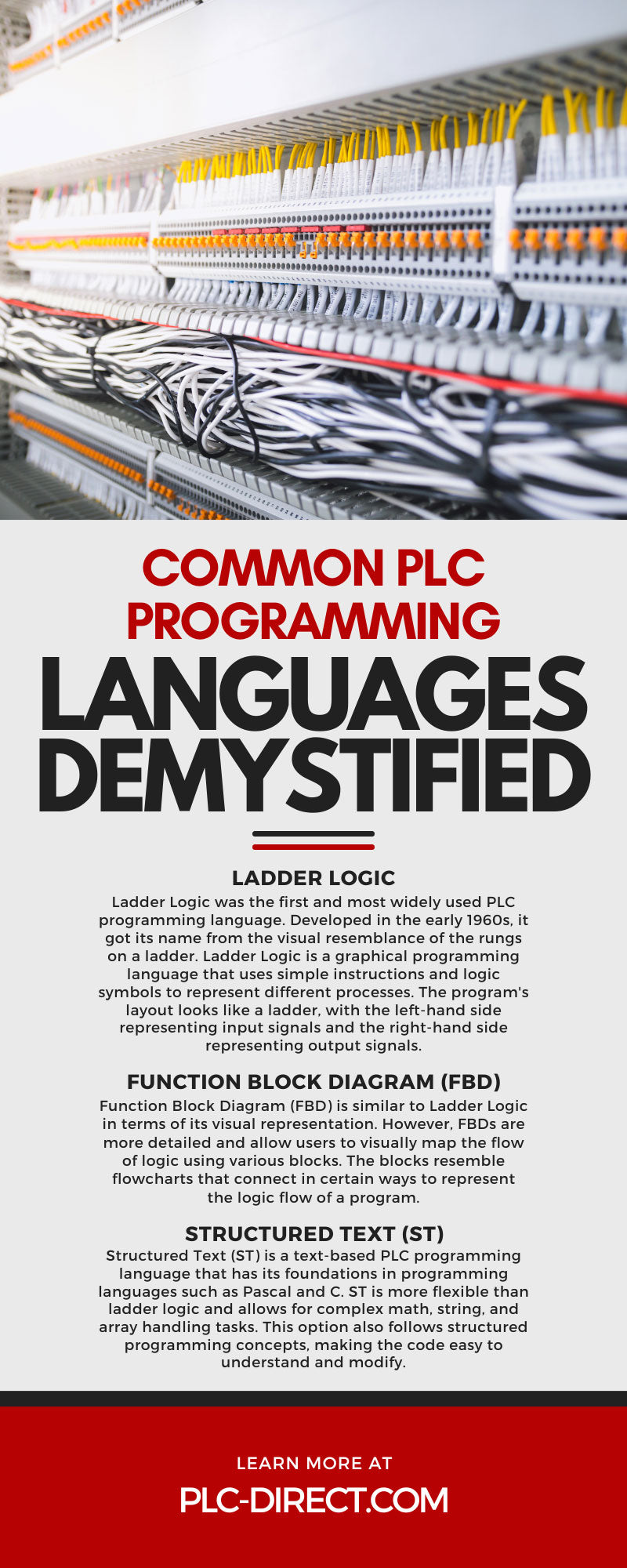It's no secret that programmable logic controllers are one of the most popular ways to automate facility operations. When programmed correctly, they can accommodate many of your equipment needs. However, there are several ways to program a PLC, and selecting the right language is the key to your long-term success. Here, we’ll demystify some common PLC programming languages and discuss how to go about choosing one for your processes.
The Importance of Choosing the Right Language
The language you choose for a PLC can make all the difference in the successful operation of your system. The right language will ensure your PLC executes operations efficiently and effectively. There are many languages available, each with its own specific advantages and disadvantages. For example, some require an understanding of electrical diagrams, while others are more flexible and can perform complex operations. Choosing the wrong language can lead to slow performance, errors, and difficulty troubleshooting. Ultimately, taking the time to research and select the appropriate language will save you time and money while ensuring your PLC operates at its fullest potential.
Top PLC Programming Languages To Know
Now that you know why this decision is so vital to your business, it’s time to dive into the specifics of some of the most common PLC programming languages out there. This is what you need to know.
Ladder Logic
Ladder Logic was the first and most widely used PLC programming language. Developed in the early 1960s, it got its name from the visual resemblance of the rungs on a ladder. Ladder Logic is a graphical programming language that uses simple instructions and logic symbols to represent different processes. The program's layout looks like a ladder, with the left-hand side representing input signals and the right-hand side representing output signals.
One of the primary benefits of ladder logic is its ease of use. The graphical layout makes it easy to understand and visualize the processes. It's a great choice for simple control tasks, such as starting and stopping a motor or controlling the speed of a conveyor belt. However, ladder logic does have some limits in its complexity, and debugging can be challenging. Further, it can be difficult to modify existing programs, which can lead to downtime.
Function Block Diagram (FBD)
Function Block Diagram (FBD) is similar to Ladder Logic in terms of its visual representation. However, FBDs are more detailed and allow users to visually map the flow of logic using various blocks. The blocks resemble flowcharts that connect in certain ways to represent the logic flow of a program.
FBDs have significant benefits over Ladder Logic. They allow users to control tasks and perform parallel processing to increase the efficiency of control processes. FBDs are great for advanced PID and motion control applications, such as robotic arms, because of their versatility and detailed representation. However, they can be a bit more difficult for the beginner programmer to use.
Structured Text (ST)
Structured Text (ST) is a text-based PLC programming language that has its foundations in programming languages such as Pascal and C. ST is more flexible than ladder logic and allows for complex math, string, and array handling tasks. This option also follows structured programming concepts, making the code easy to understand and modify.
ST is an excellent choice for complex control tasks that require decision-making or mathematical calculations. It's also beneficial for tasks that involve heavy data processing. However, ST can be challenging for new users to understand, as it's a text-based language, and syntax errors can cause logic faults, leading to downtime. Make sure you train your technicians in this type of language before asking them to write a program with it.
Instruction List (IL)
The Instruction List (IL) is a low-level PLC programming language that is similar to the assembly language used in computer programming. In an IL program, each command corresponds to one machine code instruction. This language gives direct access to the processor's architecture, which is a great resource in firmware development and microprogramming. It’s especially suited for situations requiring short reaction times and small memory usage.
IL programs are not human-readable, and you’ll require a special editor or conversion tool to write them. The commands in an IL program use a specific syntax, including the mnemonic instruction, operand, and target address. Despite its technical complications, IL remains a popular PLC programming language because of its flexibility and efficiency in resource management.
Sequential Function Chart (SFC)
Sequential Function Chart (SFC) is a PLC programming language used in automation projects where there is a need for specialized control structures. SFC is a graphically oriented language that visually represents the logical and temporal process behavior. It combines a flow chart and ladder logic, which makes it extremely useful for highly sequential control processes.
The SFC has five basic elements, including steps, transitions, actions, actions in steps, and actions on transitions. Steps are programmatic behaviors that activate when you execute all previous steps. The transitions indicate the movement from one programmatic state to another. Actions, on the other hand, are operations that execute parallel to the steps. They can either occur when a step triggers them or independently when the activity conditions are met.
How To Choose a PLC Language
As mentioned, there are several top PLC programming languages to know, each with its own set of circumstances where they shine. Because of this, it isn’t enough to simply know what these options are. You also need to understand how to select the best one for your needs. These are some tips to help you do just that.
Consider Your Application
The type and complexity of your chosen application will greatly influence the programming language you’ll use. Simple applications like conveyor belts, packaging equipment, and simple material handling tasks have fewer programming requirements and, therefore, are perfect for ladder logic or function block diagram (FBD). However, more complex applications require higher-level programming languages like Structured Text (ST). Before selecting a programming language, consider the complexity of the application and the expertise of the team tasked with programming it.
Mix and Match Languages
Mixing and matching programming languages can provide a robust and efficient control system if appropriately used. Each programming language has specific advantages and disadvantages. If you want to leverage the strengths of each language, an effective approach is to use a combination of languages to accomplish different tasks. For example, you can make the base control program using ladder logic while using another program to add customized I/O modules or specialized functions.
No One-Size-Fits-All Solution
Remember that there is no one-size-fits-all solution when choosing a PLC language, as each application has its own requirements. It's important to invest in the right programming language that meets the needs of your application. Additionally, choose a programming language developed by a reputable vendor that provides technical support, upgrades, and a solid user community.
Choosing the correct PLC and programming language for your business is critical to the success of your automated systems. PLC Direct provides premium PLCs for sale from several top industry brands, many of which are compatible with different programming languages. Shop with us today to find your perfect match.


